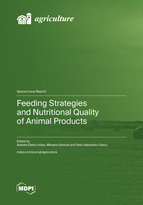Combined Effects of Parsnip Fermented Juice and Hawthorn Extract Regarding Pork Mince Stability: Physico-Chemical and Microbiological Aspects
Round 1
Reviewer 1 Report
In this study, Nicoleta Corina Predescu et al aimed to evaluate the combined effects of parsnip fermented juice and hawthorn phenolics on lipids and colour stability and also, on spoilage bacteria growth in pork mince. It’s an interesting and useful study, however, there are some problems with it:
1. The difference significance should be clearly marked in all figures.
2. The relationship among parameters, such as fatty acids profile, TBARS, and nitrosyl hemochrome content, should be discussed in this study.
Author Response
Dear reviewer,
Thank you for kindly reviewing our article!
Please see the attached letter and the reviewed manuscript.
Author Response File: ![]() Author Response.pdf
Author Response.pdf
Reviewer 2 Report
The publication is very interesting since it evaluated Parnsip fermented juice (PFJ) alone or associated with hawthorn extract (HE) as natural nitrite and antioxidant sources for pork mince, in the aim to substitute synthetic ones. The methodology and approach used were adapted to achieve the objectives assigned to the work. However, the authors have to consider these comments :
1. The title should be more precise and in relation with the interest of the work
2. Some important results are missing in the Abstract as the effects of the treatments on microbiological aspects. Moreover, it's desirable to report some data in the abstract
3. In Materials and Methods (MM) :
3.1. Why the HE has not been tested alone as PFJ to make the discussion more appropriate?
3.2. How the doses 10; 25 and 50 ppm GAE have been chosen?
3.3. The analysis of the effects of time (0-3-6 and 9 days) and the interaction between time x treatments were not evaluated. Moreover, in lines 464-465 you wrote " A significant correlation was established between PC and samples T2, T3, and T' (p < 0.001)? This correlation was not announced in MM.
4. Results and discussion :
4.1. The differences between treatments were well presented after 9 days, but what about these differences after 6 days of refrigeration? the same trends between treatments at 6 or 9 days?
4.2. Is the difference between T3 and T4 was significant at any time?
4.3. Lines 226-229: Is this explanation of the slight increase of pH T1, T2, T3 and T4 comes from results or from a bibliography?
4.4. The results of statistical analysis (precisely the superscript letters) of table 2 should be strongly reviewed :
4.4.1. C18:2 n-6 in T3 and T4 the value is the same = 13.52 %, but different significantly?
4.4.2. More surprising the statistical letters reported for C18:3n-3 (alpha): differences between NC (0.54) and PC (0.71) NS and between NC (0.54) and T3 (0.65) and T4 (0.60) the differences are significant?
4.5. Lines 332-334: It is not necessary to remind wit h all the details of PC the treatment.
4.5. Lines 268- 272: T3 and T4 protect also C18:3n-6 as the three other essential fatty acids in comparison of NC.
4.6. Lines 290-291: the addition of HE affects TBARS values in concentration-dependent-manner? But TBARS values of T2 >T4>T3 after 6 days. After 9 days, these differences between T3and T4 seem to be non significant, isn't it?
4.7. Lines 345-346: the content of NO-Heme "decreased"? in the order T2, T3 and T4.
4.8. Line 460: frome "de" day 0 to day 3.
4.9. Figures 3 and 5 : NC treatment was not represented whereas it was mentioned in the legend.
4.10. One the main results concerned the microbiological data since even after 6 days, for T4, and especially after 9 days for all treatments "TVC was higher 5.69 logs CFU/g and so, not acceptable for safe consumption". This important result was minimized in the discussion.
4.10. Overall, the discussion was not very refined and the authors limited it to a comparison. Particularly, the links between all the parameters measured were not well discussed.
5. The Conclusion did not totally support the results since one of the main result as the mircobiological aspects were not mentioned whereas they may restrict the use of HE and PJF.
Author Response
Dear reviewer,
Thank you for kindly reviewing our article!
Please see the attached letter and the manuscript.
Author Response File: ![]() Author Response.pdf
Author Response.pdf
Round 2
Reviewer 2 Report
Thank you for the different explanations in your letter and in the text. The different corrections and the additions are very interesting and made several clarifications, which were not well presented in the previous version. The great modifications made in the presentation of the tables are what I expected.






